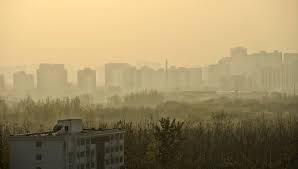Lahore (Web Desk): Some cities of China, Pakistan and India are facing Smog that is raising health concerns among the people and for those people who are exposed to it on a daily basis, it can be more harmful to health.
Smog is one type of outdoor air pollution that can cause particular problems for people with existing health problems, including chest, lung or heart complaints.
A recent research claimed that outdoor air pollution could be responsible for 3.3 million premature deaths across the globe every year.
What is Smog?
Smog is basically derived from the merging of two words; smoke and fog. Smog is also used to describe the type of fog which has smoke or soot in it.
The terminology refers to a mixture of liquid and solid fog and smoke particles. It is usually seen as yellowish or blackish fog which suspends in the atmosphere or forms a ceiling in the air. It happens when fume, emissions, and particulates (nitrogen and sulfur oxides and volatile organic compounds) react in the presence of sunlight to form ground-level ozone. Ozone, which protects our skin from harmful UV rays when it’s high in the atmosphere, can be harmful and cause irritating health effects when it’s nearer the ground
Smog which occurs mainly because of air pollution, can also be defined as a mixture of various gases with dust and water vapor. Smog also refers to hazy air that makes breathing difficult; it will irritate your lungs and airways; and it will worsen chronic diseases such as heart disease, chronic bronchitis, emphysema and asthma. Since air pollution can be harmful to your health, even when a smog alert isn’t issued, it is important to watch out for the following signs:
• Breathing difficulties
• Chest tightness
• Cough or throat irritation
• Eye irritation
• Light-headedness
• Wheezing
If you have breathing problems, contact your healthcare professional for advice on how to cope with the health effects of air pollution.
How can you protect yourself from smog?
If you have respiratory issues that are affected by smog and air pollution – or simply want to protect yourself or your children from the potential health effects – here are some practical tips to help you:
1. Keep up to date with weather forecasts and smog throughout the year. You can find a daily update on air quality at the Air Quality website. The Department for Environment, Food and Rural Affairs (DEFRA) also has the latest information and includes a useful colour-coded summary of the current situation in all areas of the UK. If you’re travelling and want to know about how smog might affect you in Europe, the European Environment Agency maintains an ozone map on its website.
2. If the air quality forecast is poor, where possible, avoid the affected areas. If this is too difficult, stay indoors and keep your windows closed.
3. Avoid exercising in smoggy conditions, particularly at midday when ground ozone levels are at their highest. Try to change the times you exercise to morning or evening (avoiding rush hour), or exercise inside.
4. If you’re asthmatic or have COPD, carry your inhaler at all times. If you notice any rapid deterioration in your condition, consult your doctor.
5. If you have respiratory conditions and need to travel on smoggy days, avoid congested areas where you may get stuck in traffic jams. Road junctions can be a hotbed of exhaust emissions so keep your windows closed. Airports, seaports and industrial areas also tend to have high levels of pollutants so avoid these too.
6. If you’re walking or cycling to work, plan a route that avoids too many areas that are built up or congested.
7. Keep your own emissions to a minimum. Avoid unnecessary car journeys in cities, don’t rev up or leave your engine running for a long time outside your home on cold days or when stuck in traffic jams.


